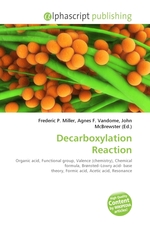Decarboxylation Reaction
Frederic P. Miller, Agnes F. Vandome, John McBrewster
бумажная книга
High Quality Content by WIKIPEDIA articles! Carboxylic acids are organic acids characterized by the presence of at least one carboxyl group. The general formula of a carboxylic acid is R-COOH, where R is some monovalent functional group. A carboxyl group (or carboxy) is a functional group consisting of a carbonyl and a hydroxyl, which has the formula -C(=O)OH, usually written as -COOH or -CO2H. Carboxylic acids are Br nsted-Lowry acids, they are proton donors. They are the most common type of organic acid. Among the simplest examples are the formic acid H-COOH, that occurs in ants, and acetic acid H3C-COOH group, that gives vinegar its sour taste. Acids with two or more carboxyl groups are called dicarboxylic, tricarboxylic, etc. The simplest dicarboxylic example is oxalic acid (COOH)2, which is just two connected carboxyls. Mellitic acid is an example of a hexacarboxylic acid. Other important natural examples are citric acid (in lemons) and tartaric acid (in tamarinds). Salts and esters of carboxylic acids are called carboxylates. When a carboxyl group is deprotonated, its conjugate base, a carboxylate anion is formed.
Данное издание не является оригинальным. Книга печатается по технологии принт-он-деманд после получения заказа.


